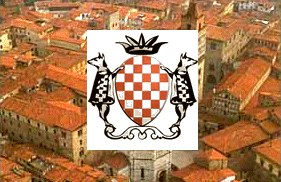     |
 DISCOVERING
PISTOIA DISCOVERING
PISTOIA
CHIESA DI SANT'ANDREA
- S.Andrea Church
 This
church Is certainly of ancient origin; in fact many clues tell us that
the foundation must date back to the period of Lombard rule. Although it
has sometimes been identified as the paleo-Christian cathedral
because of the orientation of its apse, the Church of Sant'Andrea
probably dates back to the seventh century. It was renovated into its
present form around the mid twelfth century. The building's
distinguishing characteristics can be seen firstly on the front where
the polychrome inlays present three doorways of which the middle one has
an architrave with carved scenes. This was sculpted by Gruamonte after
the mid twelfth century and portrays the Journey of the Magi; this
unusual iconographic choice suggests a particular relationship between
this church and that urban part of the via Franchigena along which it
had been built. Stylistically both Gruamonte and Enrico (the master who
signed the two capitals that support the architrave) belonged to the
stylistic movement, headed by Guglielmo, that had developed around the
cathedral of Pisa. The church's interior, divided into three naves with
columns and a semi-circular apse, can be fully ascribed to the general
renewal that involved the major Pistoian churches in the mid twelfth
century. Its appearance today was uncovered by a series of restorations,
particularly by the most recent ones which tore out much of the work
that had been added over the centuries; today we see a building which is
certainly austere and suggestive but different from the original. The
richness of its colors can still be seen in some of the few remaining
frescos. The church houses great works of art that make it one of the
most interesting places in the region. Among these there are the Pulpit
sculpted by Giovanni Pisano at the end of the thirteenth century and the
wooden Crucfix, on the first altar on the left wall, that Giovanni
carved for the Church of Santa Maria Ripalta The enclosure of the
presbytery whose panels were sculpted in Romanesque times (today located
on the right wall, was thus described in the local guidebooks of the
last century: around the presbytery there are rosone-shaped marble
panels with decorations in low relief. The high altar, commissioned by
the Pappagalli family in the late eighteenth century has been
substituted by an altar obtained by reworking a thirteenth century
tombstone that had been uncovered during excavations near Pistoia. In a
Renaissance tabernacle on the right hand wall Is another wooden Crucifix
attributed to Giovanni Pisano while the round wall of the apse is
decorated with an impressive depiction of the Blessing of God the Father
painted in 1506 by the Pistoian artist Bernardino del Signoraccio. This
church Is certainly of ancient origin; in fact many clues tell us that
the foundation must date back to the period of Lombard rule. Although it
has sometimes been identified as the paleo-Christian cathedral
because of the orientation of its apse, the Church of Sant'Andrea
probably dates back to the seventh century. It was renovated into its
present form around the mid twelfth century. The building's
distinguishing characteristics can be seen firstly on the front where
the polychrome inlays present three doorways of which the middle one has
an architrave with carved scenes. This was sculpted by Gruamonte after
the mid twelfth century and portrays the Journey of the Magi; this
unusual iconographic choice suggests a particular relationship between
this church and that urban part of the via Franchigena along which it
had been built. Stylistically both Gruamonte and Enrico (the master who
signed the two capitals that support the architrave) belonged to the
stylistic movement, headed by Guglielmo, that had developed around the
cathedral of Pisa. The church's interior, divided into three naves with
columns and a semi-circular apse, can be fully ascribed to the general
renewal that involved the major Pistoian churches in the mid twelfth
century. Its appearance today was uncovered by a series of restorations,
particularly by the most recent ones which tore out much of the work
that had been added over the centuries; today we see a building which is
certainly austere and suggestive but different from the original. The
richness of its colors can still be seen in some of the few remaining
frescos. The church houses great works of art that make it one of the
most interesting places in the region. Among these there are the Pulpit
sculpted by Giovanni Pisano at the end of the thirteenth century and the
wooden Crucfix, on the first altar on the left wall, that Giovanni
carved for the Church of Santa Maria Ripalta The enclosure of the
presbytery whose panels were sculpted in Romanesque times (today located
on the right wall, was thus described in the local guidebooks of the
last century: around the presbytery there are rosone-shaped marble
panels with decorations in low relief. The high altar, commissioned by
the Pappagalli family in the late eighteenth century has been
substituted by an altar obtained by reworking a thirteenth century
tombstone that had been uncovered during excavations near Pistoia. In a
Renaissance tabernacle on the right hand wall Is another wooden Crucifix
attributed to Giovanni Pisano while the round wall of the apse is
decorated with an impressive depiction of the Blessing of God the Father
painted in 1506 by the Pistoian artist Bernardino del Signoraccio.

PISTOIA
PHOTOGALLERY
PISTOIA CITY MAP
|

